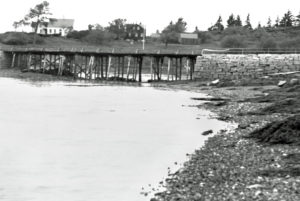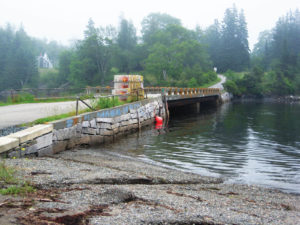
The challenge
In 2013, the small town of North Haven on North Haven Island off the coast of Maine, began construction on a unique bridge project. The goal was to rebuild Beach Bridge, a deteriorating structure that provided access to a handful of seasonal homes and an important wharf for local lobstering as well as summertime swimming for tourists.
The little hamlet faced several challenges with this project:
- North Haven Island is about 12 miles from Rockland, the closest mainland connection. All construction materials and equipment had to be transported to the island by boat and barge.
- Significant daily tidal fluctuations affected the duration of daily construction. At high tide, most of the bridge abutments would actually be under water.
- The town’s administration (a board of selectmen) wanted to integrate an existing pier with the new bridge construction to minimize construction time and costs.
- Construction needed to be completed during the late winter/early spring to minimize the impact on residents, anglers, and summer tourists.
- The bridge’s retaining walls had to withstand potential impacts from boats navigating the waterway.

Meeting the challenges
The remote location of North Haven led the design team to search for a more efficient solution than a typical pile-driven foundation for the bridge abutments. The answer was a Geosynthetic Reinforced Soil–Integrated Bridge System (GRS-IBS), completed as a joint effort by the town of North Haven and the Maine Department of Transportation (DOT).
GRS–IBS bridge building has long been championed by the Federal Highway Administration (FHWA) and is especially popular with county engineers for its time- and money-saving efficiencies. Building a GRS bridge abutment is a three-step process. First, a row of blocks is put into place. Second, a layer of fill is compacted to the height of the facing blocks. Third, a layer of geotextile is extended between the rows of blocks to connect them to the GRS mass. The 1-2-3 process is repeated until the wall height is reached. Precast concrete box beams can be placed directly on the GRS abutments without a concrete footing.

“A GRS wall was by far the cheapest and easiest to incorporate in that type of environment,” explained Josh Olund, a bridge engineer with the design firm, T.Y. Lin International. Olund also noted that with the deteriorated abutments replaced with geosynthetic-reinforced soil walls, “This is the first time a GRS wall has been used in a marine or tidal environment. It’s also the first time being used in a two-span bridge arrangement.”
Another engineer on the project, Jeff Benway with SFC Engineering Partnership Inc., added: “The main difference between a GRS wall and a traditional mechanically stabilized earth (MSE) abutment wall is that reinforcing fabric is used in much more closely spaced layers. It doesn’t have the same strength as geogrid, but it’s much more closely spaced, every 6 to 9 inches (150 to 230 millimeters) vs. every 18 inches (457 millimeters) with a traditional retaining wall. This allows the fabric to act as a tension element in the soil. The facing unit isn’t really retaining the soil at all; it’s simply preventing erosion of the reinforced soil mass.”
The existing bridge pier was in good shape and was reused by installing lightweight concrete beams that were specified by the engineering team. The limestone-textured wall blocks matched the aesthetic look of the existing bridge pier and fit in with the natural look of the environment.

“This is located in one of the most spectacular sailing harbors along the coast of Maine,” said Joe Stone, North Haven administrator. “It was important that the natural scenic beauty of the site not be damaged by the bridge.”
Since the bridge abutment is partially submerged at high tide, the blocks were cast using a low permeability concrete mix that met all Maine DOT specs. These blocks were custom-made because they required flat tops and bottoms with no shear knob or groove.
This custom block design allowed the geotextile fabric to be sandwiched between the flat blocks, a key engineering component of the GRS design technology. The design also included intermediate, non-attached layers of geotextile, located at mid-height of the blocks every 9 inches (230 millimeters).
A benefit of using wet cast, precast modular blocks in a project such as this is that the installation crew could compact the reinforced soil mass right up to the back of the blocks. The large size of each block allowed the facing structure to handle compaction of the soil directly behind it.

“This area doesn’t get wave action, but there’s a very large tidal change, around 6 to 8 feet (1.8 to 2.4 meters),” said SFC’s Benway. “They wanted to use a larger block system that could withstand the tidal changes as well as potential impact from boats.”
Even though the tidal fluctuations posed a challenge for the installers, the crew was able to meet its original schedule, according to T.Y. Lin’s Olund. The overall duration for the project was about four to five months, which included everything from demolition through final construction. Initial demo started in the harsh weather of January, and the bridge was completed and opened by Memorial Day.

Outcomes
At the tallest point, the abutment walls stand at 15 feet (4.6 meters), with 4 feet (1.2 meters) buried. The project included a total of 344 blocks, equaling 1,918 square feet (178.2 square meters).
“It’s been widely accepted by the property owners that abut it and the fishermen who use it,” Stone said. “People appreciate the fact that it’s more robust and safer than its predecessor and built to modern standards.”
Lindsey O’Connor is the marketing manager at Redi-Rock International in Charlevoix, Mich.
Geosynthetics senior editor, Ron Bygness, also contributed to this article.
 TEXTILES.ORG
TEXTILES.ORG


